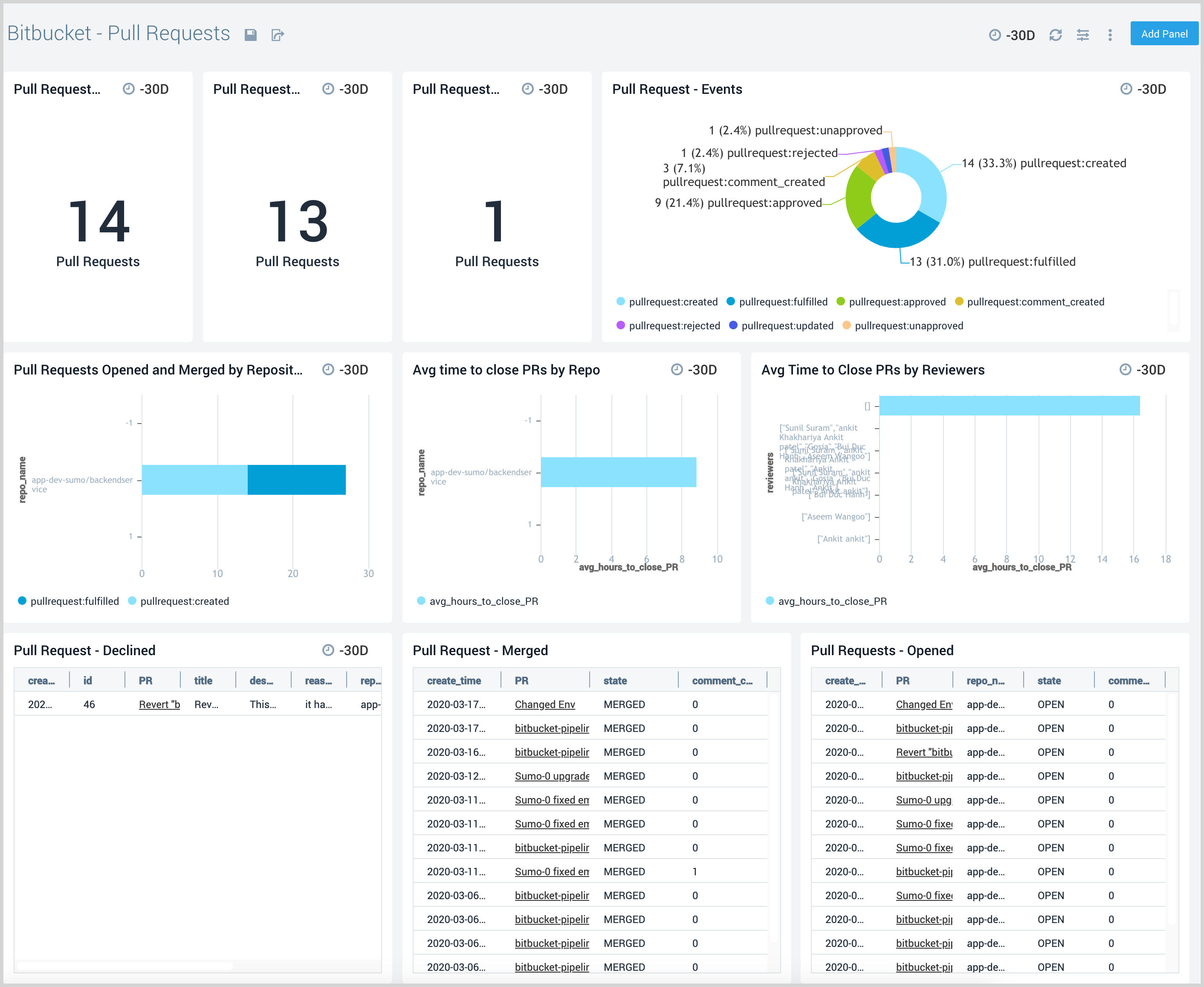Sumo Logic App for Bitbucket

The Sumo Logic App for Bitbucket provides insights to development teams into how their software delivery pipeline components are performing. The pre-configured dashboards organize issues, builds, and deployments that require the most attention.
The Bitbucket App supports only Bitbucket Cloud.
Event Types
Sumo Logic analyzes the following required types of logs for more efficient monitoring.
There are two types of events of interest from Bitbucket to Sumo Logic: Bitbucket and Deploy events. This section provides an example of Bitbucket Events and Deploy Events log messages.
Bitbucket Events
Bitbucket Events send the event request to the server URL for the Webhook whenever that event occurs.
Available Repository events
Available Issue events
Refer to the event documentation for descriptions and examples of each event payload above.
For log samples, refer to Bitbucket Event Documentation
Sample Log
Deploy Events are triggered whenever code is pushed to test, staging, or production environments.
- Success Code Deploys
- Failed Code Deploys
{
"buildNumber": "160",
"deploymentEnvironment": "production",
"gitHttpOrigin": "http://bitbucket.org/sumo/backendservice",
"commit": "67be2cdb4db18556df9b49872d7d3945ada3cb09",
"branch": "master",
"tag": "",
"prDestinationBranch": "",
"projectKey": "",
"repoFullName": "app-dev-sumo/backendservice",
"repoOwner": "app-dev-sumo",
"pr_id": "",
"pipe_result_link": "https://bitbucket.org/sumo/backendservice/addon/pipelines/home#!/results/160",
"deploy_status": "0",
"commit_link": "https://bitbucket.org/sumo/backendservice/commits/67be2cdb4db18556df9b49872d7d3945ada3cb09",
"event_date": "2020-03-23 08:07:34"
}
Sample Query
This section provides a sample from the Failed Deployments panel on the Bitbucket Deployment dashboard.
Parameters:
- Event_Date:*
- Build_Number:*
- Deploy_Status:*
- Deployment_Environment:*
- Files_Committed:*
- Repo_Full_Name:*
- Repo_Owner:*
- Source_Branch:*
- Deploy_Result:*
_sourceCategory="bitbucket" production deploymentEnvironment pipe_result_link deploy_status commit_link
| json field=_raw "buildNumber", "deploymentEnvironment", "branch", "repoFullName", "pipe_result_link", "deploy_status", "pr_id", "commit", "tag", "projectKey", "repoOwner", "commit_link" , "event_date"
| repoFullName as repo_name
| where repoFullName matches "*" AND buildNumber matches "*"
| branch as source_branch
| if (deploy_status matches "0", "Success", "Failed") as deploy_status
| where deploymentEnvironment="production" and deploy_status="Failed"
| tourl (commit_link, concat("Commit # ",commit)) as files_commited
| tourl (pipe_result_link, buildNumber) as deploy_result
| count by event_date, buildNumber, deploy_status, deploymentEnvironment, files_commited, repoFullName, repoOwner, source_branch, deploy_result
| fields - _count
Collecting Logs for Bitbucket App
This section provides instructions for configuring log collection for the Bitbucket App. Configuring log collection consists of the following tasks:
Step 1: Configure Hosted Collector to Receive Bitbucket events
In this step, you configure a Hosted Collector to receive Webhook Events from Bitbucket and set up an HTTP source on it.
- Configure a Hosted Collector, or select an existing hosted collector for the HTTP source.
- Configure an HTTP source on the hosted collector.
- For Source Category, specify
bitbucket/events. - Click +Add Field and provide the following:
- Field Name.
_convertHeadersToFields - Value.
true
- Field Name.
- Click Save and make note of the HTTP address for the source. You will supply it when you configure a Jira Webhook in the next step.

- For Source Category, specify
Step 2: Adding a Webhook in Bitbucket
- From Bitbucket, open the repository where you want to add the Webhook.
- Click the Settings link on the left side.
- From the links on the Settings page, click the Webhooks link.
- Click the Add Webhook button to create a Webhook for the repository. The Add New Webhook page appears.
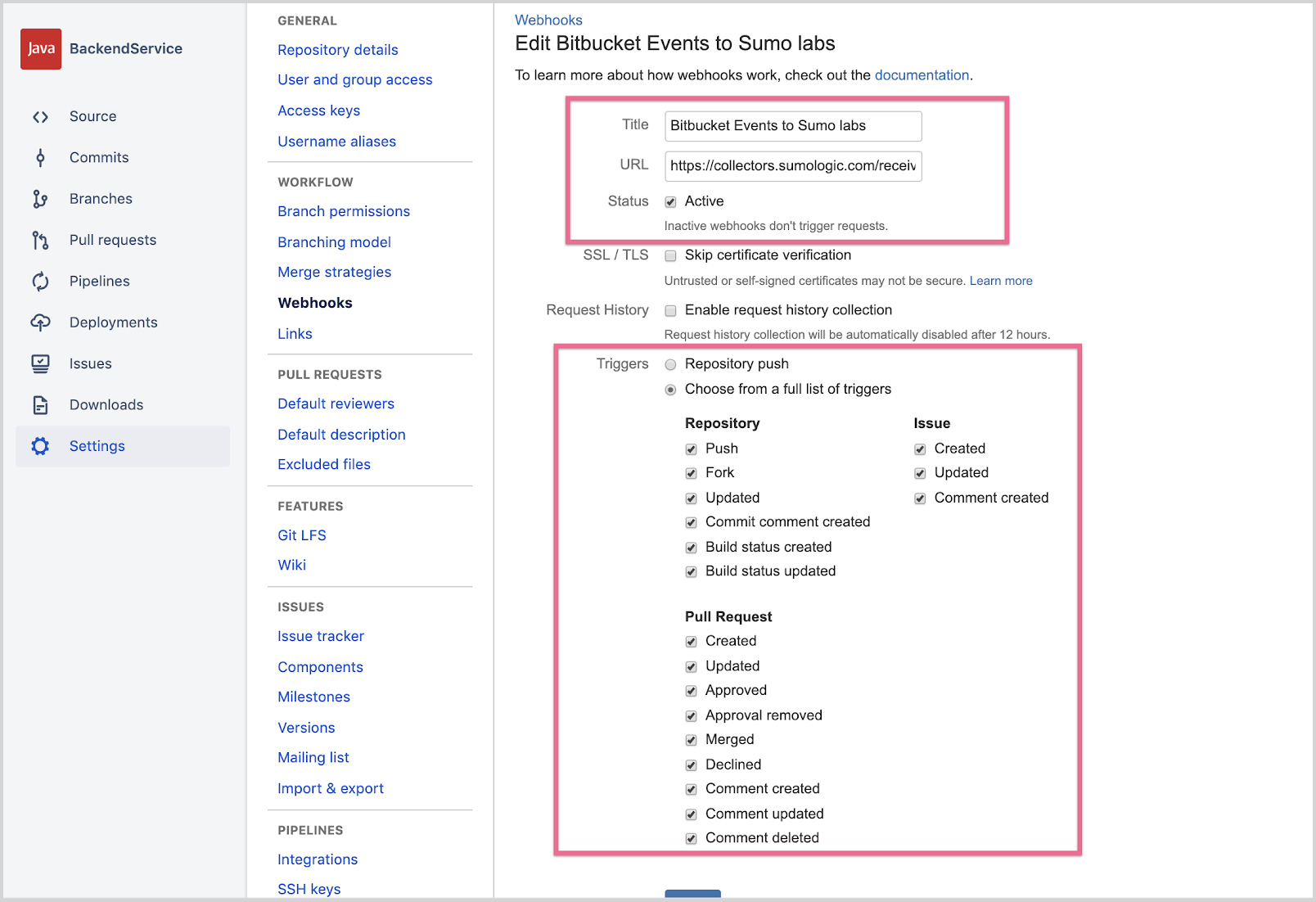
- Enter a Title with a short description.
- Enter Sumo Logic Http source URL, you configured this in Configure Hosted Collector to Receive Bitbucket events.
- Click on Status to make it Active.
- Triggers - Click on Choose from a full list of triggers, and choose all triggers under Repository, Issue and Pull Request.
- Click Save
Step 3: Configure the Bitbucket CI/CD Pipeline to Collect Deploy Events
A Bitbucket pipe needs to be configured to send code deploy status to Sumo Logic. Add the following pipe code to the step section of your deployment part of the bitbucket-pipelines.yml file. Replace SUMOLOGIC_HTTP_URL with HTTP Source URL configured in Step 1.
after-script:
- pipe: docker://appdevsumologic/sumologic-send-event:1.15
variables:
SUMO_LOGIC_BASE_URL: '<SUMOLOGIC_HTTP_URL>'
If you want to deployment events to multiple Sumo Logic orgs, include a -pipe statement, as shown above, for each of the Sumo Logic endpoints.
For reference: This is how the bitbucket-pipelines.yml looks after adding deploy pipe code to our sample Bitbucket CI/CD pipeline.
Step 4: Enable Bitbucket Event-Key tagging at Sumo Logic
Sumo Logic needs to understand the event type for incoming events (for example, repo:push events). To enable this, the X-Event-Key event type needs to be enabled. To enable this, perform the following steps in the Sumo Logic console:
- From Sumo Logic, go to Manage Date > Logs > Fields.
- Add Field X-Event-Key.
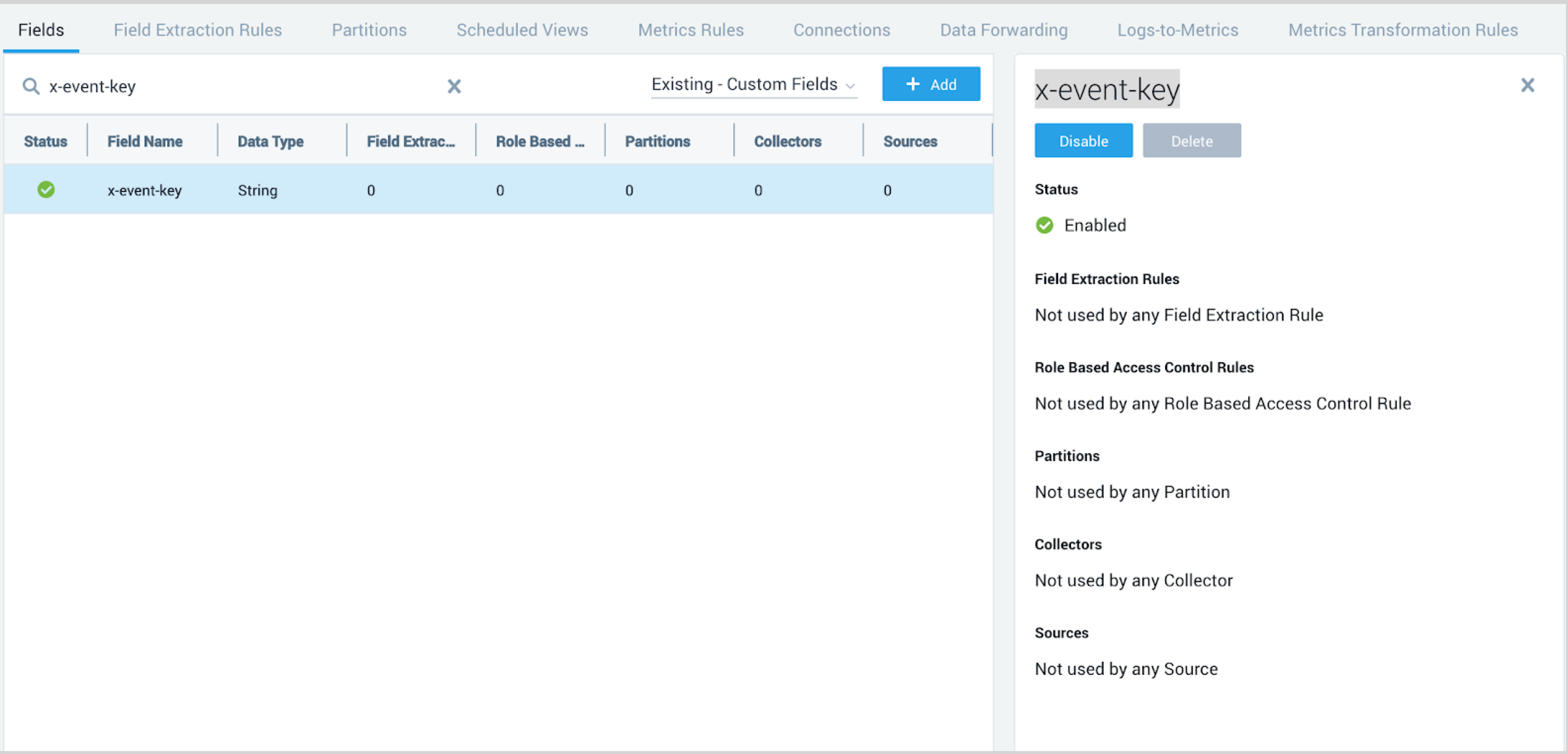
Installing the Bitbucket App
This section provides instructions for installing the Bitbucket app. To install the app, do the following:
Locate and install the app you need from the App Catalog. If you want to see a preview of the dashboards included with the app before installing, click Preview Dashboards.
- From the App Catalog, search for and select the app.
- Select the version of the service you're using and click Add to Library. Version selection is applicable only to a few apps currently. For more information, see the Install the Apps from the Library.
- To install the app, complete the following fields.
- App Name. You can retain the existing name, or enter a name of your choice for the app.
- Data Source. Select either of these options for the data source.
- Choose Source Category, and select a source category from the list.
- Choose Enter a Custom Data Filter, and enter a custom source category beginning with an underscore. Example: (
_sourceCategory=MyCategory).
- Advanced. Select the Location in Library (the default is the Personal folder in the library), or click New Folder to add a new folder.
- Click Add to Library.
Once an app is installed, it will appear in your Personal folder, or other folder that you specified. From here, you can share it with your organization.
Panels will start to fill automatically. It's important to note that each panel slowly fills with data matching the time range query and received since the panel was created. Results won't immediately be available, but with a bit of time, you'll see full graphs and maps.
Viewing Bitbucket Dashboards
This section provides descriptions and examples for each of the pre-configured app dashboards.
Template variables provide dynamic dashboards that can rescope data on the fly. As you apply variables to troubleshoot through your dashboard, you view dynamic changes to the data for a quicker resolution to the root cause. You can use template variables to drill down and examine the data on a granular level. For more information, see Filter with template variables.
Overview
The Bitbucket - Overview dashboard provides an overview of issues by repository, pull requests, builds and deployment status. Panels identify key trends and summarize the status across each workflow.
Use this dashboard to:
- Quickly get insight around how various Bitbucket components are being used.
- Drill-down into the specifics of builds, deploy or commit events.
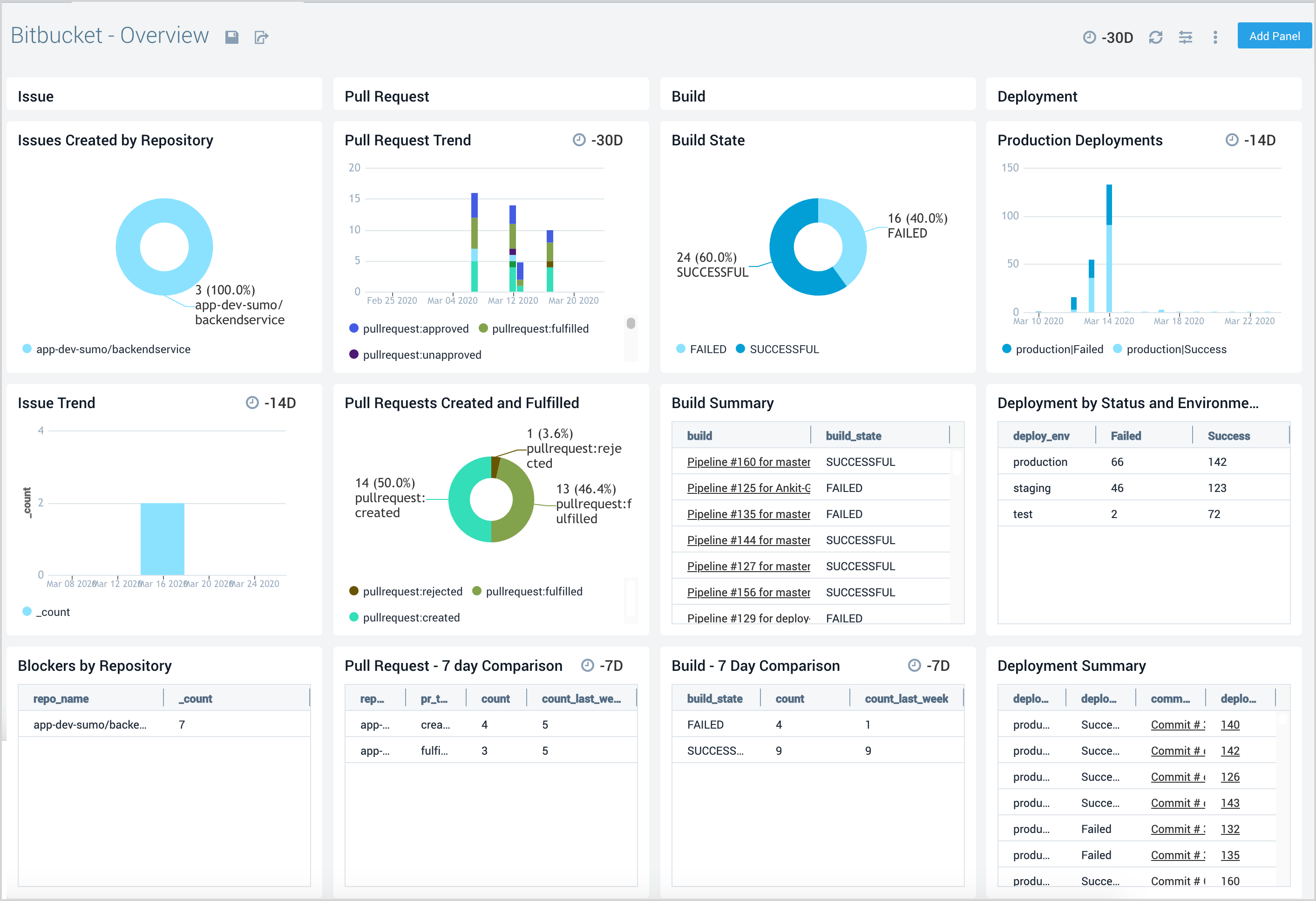
Deployments
The Bitbucket - Deployments dashboard provides details around failed and successful deployments in production, staging, and test environments
Use this dashboard to:
- To confirm whether code was successfully deployed to production.
- To understand and drill-down into commits that led to failed deployments.
- Identify and investigate deploys to various environments that led to bugs or degradation in performance.
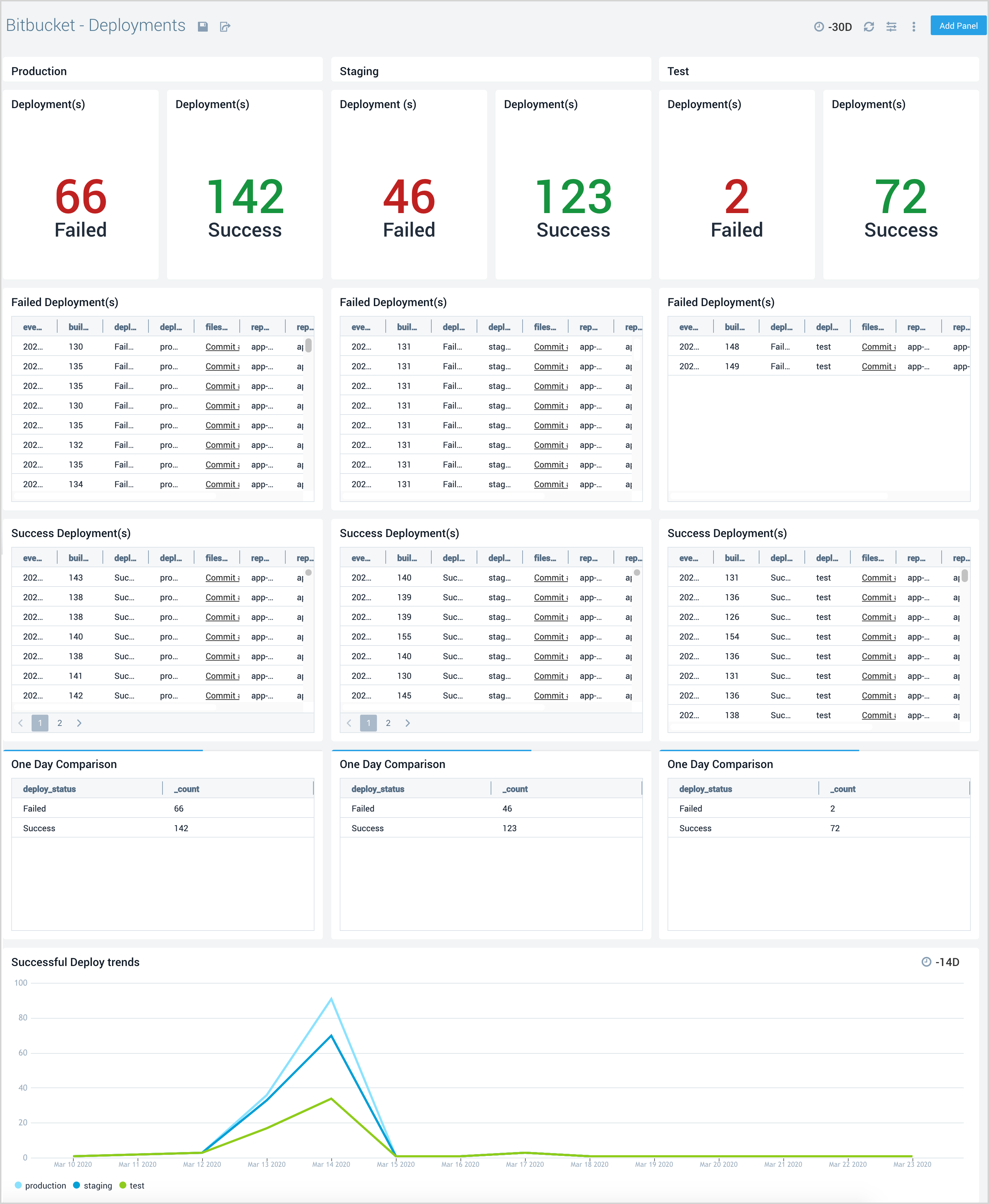
Builds
The Bitbucket - Builds dashboard provides a detailed view of the failed and successful builds overtime and by repository. It also lists the details of each build which includes the time when it was started and also identifies the changes made to the build.
Use this dashboard to:
- Speed up the overall software delivery processes by identifying bottlenecks in build failures.
- Monitor the success/failure rate of builds and identify relevant individuals, repos, and branches.
- Identify code commits that led to failed builds.

Issues
The Bitbucket - Issues dashboard provides a view of issues classified by type, priority, assignee, and project. This dashboard also provides details on issues escalated, issues summary, and issues over time.
Use this dashboard to:
- Get insights into high-level statistics around software issues.
- Improve overall software delivery processes by identifying issues by priority, projects, users, and type.
- Get insights into identifying regressions and blockers.
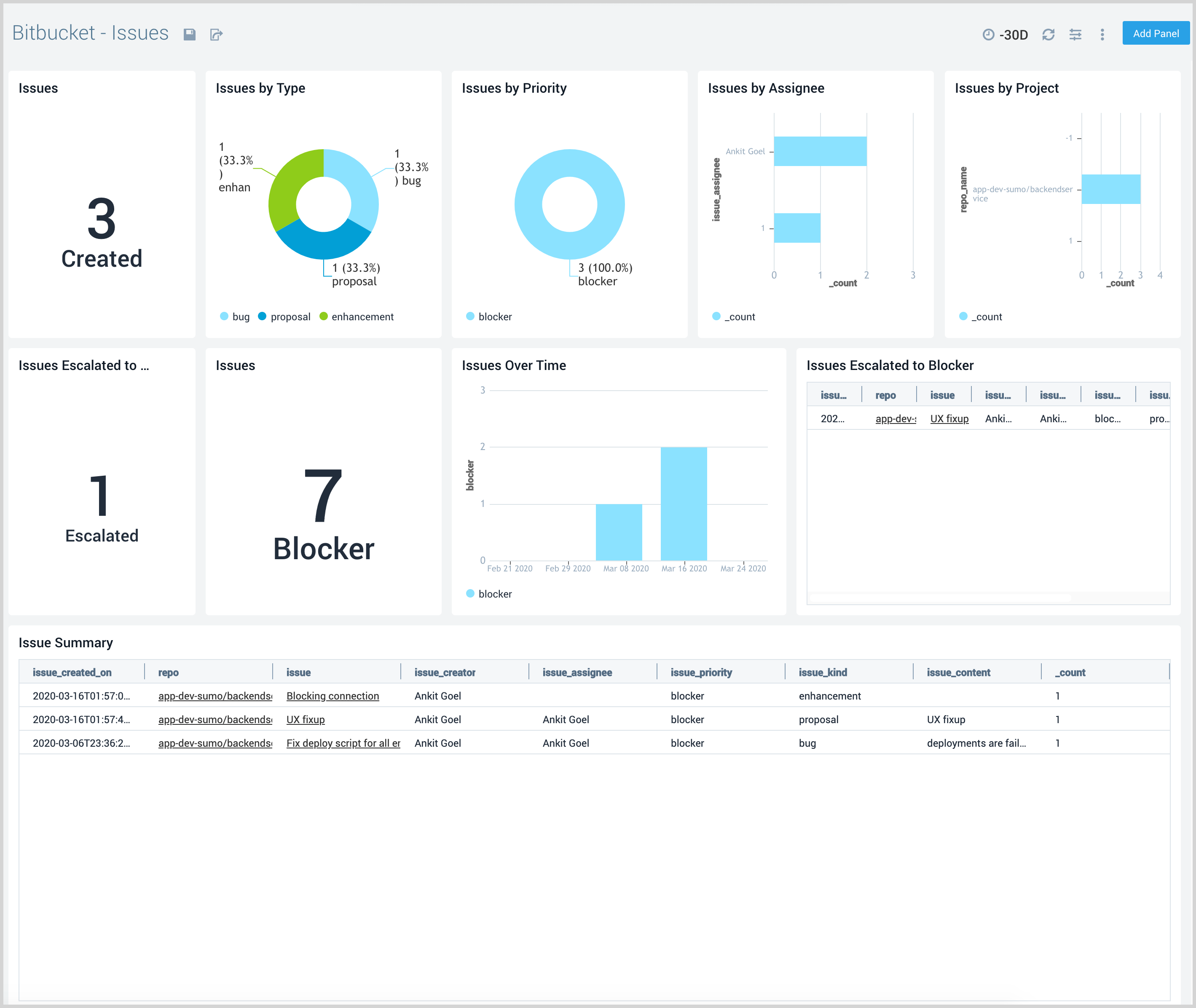
Pull Requests
The Bitbucket - Pull Request dashboard gives a view of pull requests opened, merged, and declined as well as average time taken to close the pull request by repository and by reviewers.
Use this dashboard to:
- Improve the overall software delivery processes by identifying bottlenecks in review processes.
- Identify commits and code changes.
- Identify the teams and repos that take the longest to close pull requests.
